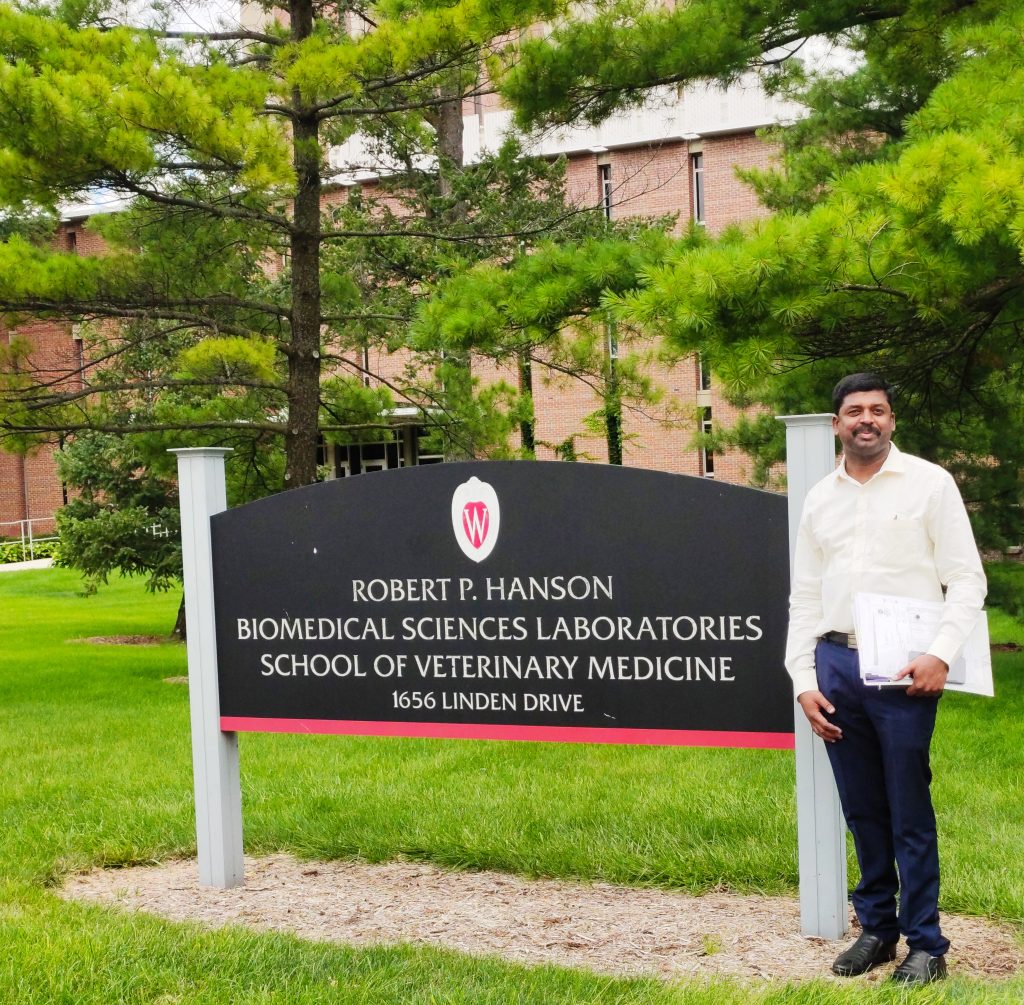
Photo S. Mani: Dr. Saminathan Mani at the Robert P. Hanson Biomedical Sciences Laboratories, School of Veterinary Medicine, UW–Madison
By Katie Newcomb, GHI Communications Director and Kendall Buehl, GHI Staffer…The Global Health Institute (GHI) has been cultivating conversations with many health leaders across government and NGOs in India over the past two years. These introductions came through the generous networking contacts of Dr. Krishna Ella and Mrs. Suchitra Ella, founders of Bharat Biotech – a vaccine and bio-therapeutic company in India. The Ellas are both GHI board of visitor members, and Dr. Ella is also a well-recognized UW–Madison alumnus. GHI is grateful to both Krishna and Suchitra for their continued leadership and support, and proud to be working in tandem to bring the OHC-India, and additional global health programs, to fruition.
Relationship cultivation included GHI Director, Jorge Osorio, and GHI Associate Director of Strategic Partnerships, Calyn Ostrowski, visiting India several times and meeting with various health leaders, including those with the Indian Council of Medical Research – Department of Health Research (ICMR-DHR), and the Indian Council of Agricultural Research – Indian Veterinary Research Institute (ICAR-IVRI).
These discussions catalyzed the opportunity to bring a researcher from the ICAR-IVRI to UW–Madison through the ICMR-DHR Long Term International Fellowship for Young Indian Biomedical Scientists programme. The fellowship programme’s goal is to augment capacity strengthening of Indian biomedical scientists by creating a talent incubator for health research personnel that provides access to advanced training through interactions with international scientists in their respective fields of study.
Photo S. Mani: Saminathan Mani-second left with Jorge Osorio-second right, Triveni Dutt, Director, ICAR-IVRI-first right, and other scientists visiting various laboratories at ICAR-IVRI to explore ongoing research initiatives and technological advancement in veterinary sciences.
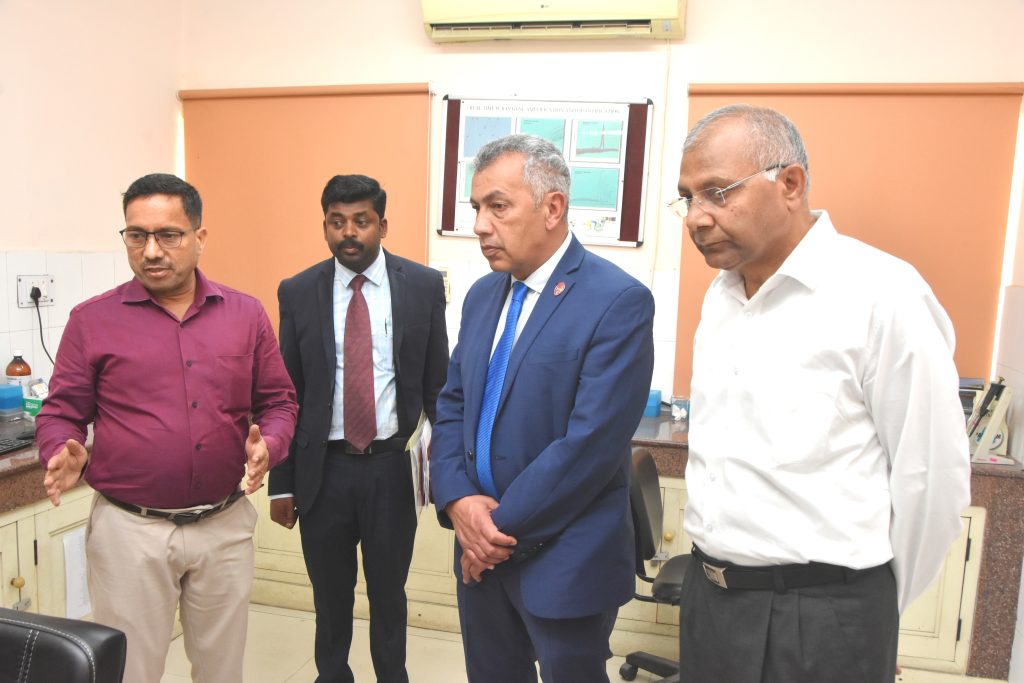
Continued conversations led to a 4:30am (India Standard Time) Zoom meeting earlier this year between Osorio and Dr. Saminathan Mani, Scientist (Senior Scale) with the Centre for Animal Disease Research and Diagnosis (CADRAD), ICAR-IVRI, to discuss the opportunity for Mani to come to UW–Wisconsin as a ICMR-DHR Fellow. Mani’s notable work, including research with the rabies virus, impressed Osorio as he could see the collaboration touch points with Mani’s work and the work being done in UW–Madison’s Department of Pathobiological Sciences at the School of Veterinary Medicine (SVM). This set in motion the focus of Mani’s fellowship: development of an oral bait rabies vaccine to help curb the wave of infections in stray dogs in India. Mani arrived at UW–Madison in late June 2024 to begin his fellowship at SVM.
But let’s take a step back to appreciate Mani’s overall journey, his achievements in India, the knowledge sharing he brings and experiences, and the hope he has to collaborate with UW–Madison on a public health solution to benefit India and beyond.
Mani grew up in Valakanampudi Medu, a rural village in R.K. Pet Taluk, Tiruvallur district in Tamil Nadu, India, with an agricultural background. He spent his formative years surrounded by animals like cows, goats, and chickens, and upon reflection, shared his upbringing instilled an appreciation for the One Health connection between humans, animals, and the planet.
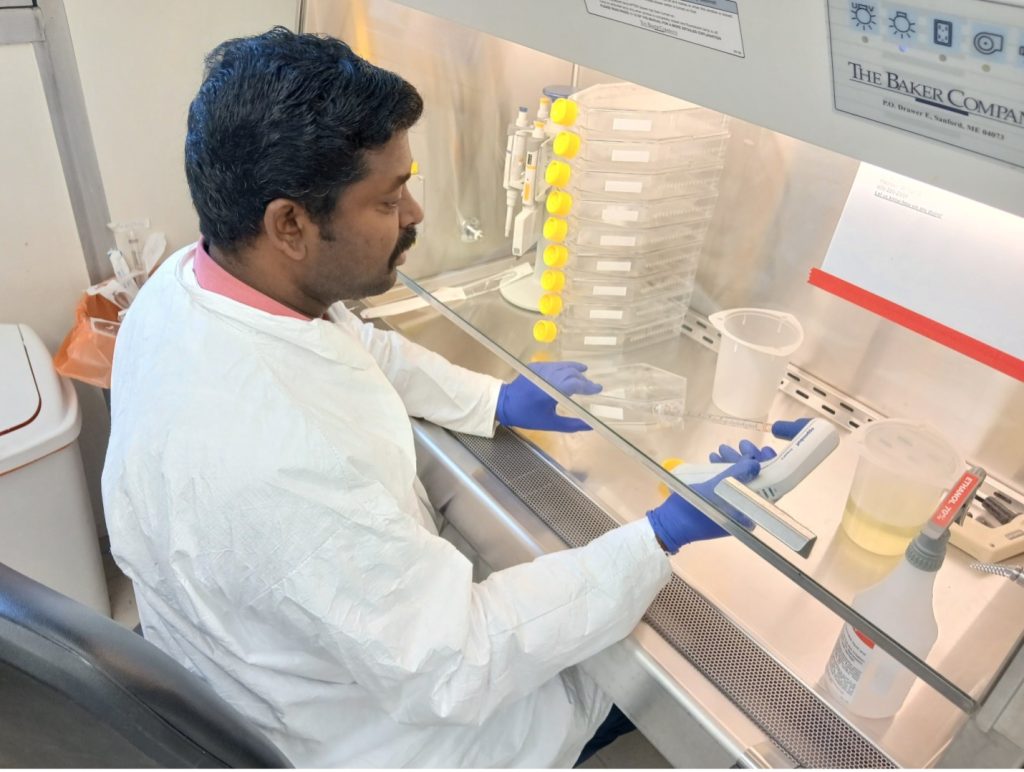
“As a veterinarian, I strongly believe the One Health concept acknowledges the health of humans is linked to the health of animals and the environment. I have realized the importance of the One Health approach for implementing prevention and control programs effectively for zoonotic diseases such as rabies, COVID-19, brucellosis, tuberculosis, Q fever, etc.,” shared Mani.
Photo S. Mani: Mani working on the cultivation of recombinant raccoonpox virus (RCN)-mosaic glycoprotein (MoG) gene of rabies virus vaccine candidate at SVM labs.
Mani completed twelve years of schooling before graduating as top student in his district and becoming the first graduate in his family. From there, he went on to college and later was the first from his village to become a postdoctoral researcher and the first to travel to the United States.
After graduating secondary school, Dr. Mani attended Madras Veterinary College to earn a Bachelor of Veterinary Science and Animal Husbandry (B.V.Sc & A.H.) degree in 2010. Mani then earned his Master’s in Veterinary Science (M.V.Sc) in the field of Veterinary Pathology from the ICAR-IVRI in 2013, and went on to earn his PhD in 2018 from ICAR-IVRI as well. ICAR-IVRI is one of the premier institutions in the South Asian region for conducting research in animal and veterinary sciences, while also imparting quality undergraduate and post-graduate education, extension, and training in veterinary and animal sciences.
Since 2015, Mani helped establish the National Animal Science and Veterinary Educational Museum (NAS & VEM) (formerly named the National Museum of Veterinary and Animal Sciences), which showcases the related histories of the ancient, medieval, and modern eras, as part of ICAR-IVRI. Before coming to Madison, Mani remained the officer in charge of this museum, which also serves as an educational hub for 5,000+ schoolchildren who visit every year.
Photo S. Mani: Mani discussing the historic exhibits in the Museum to visitors.
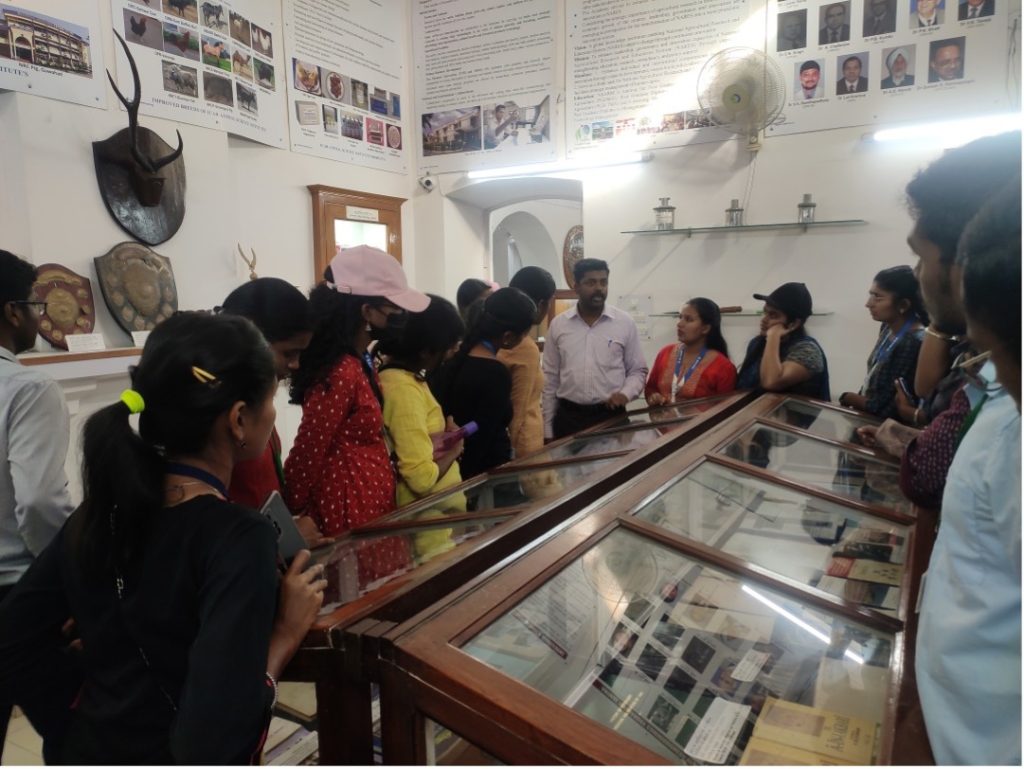
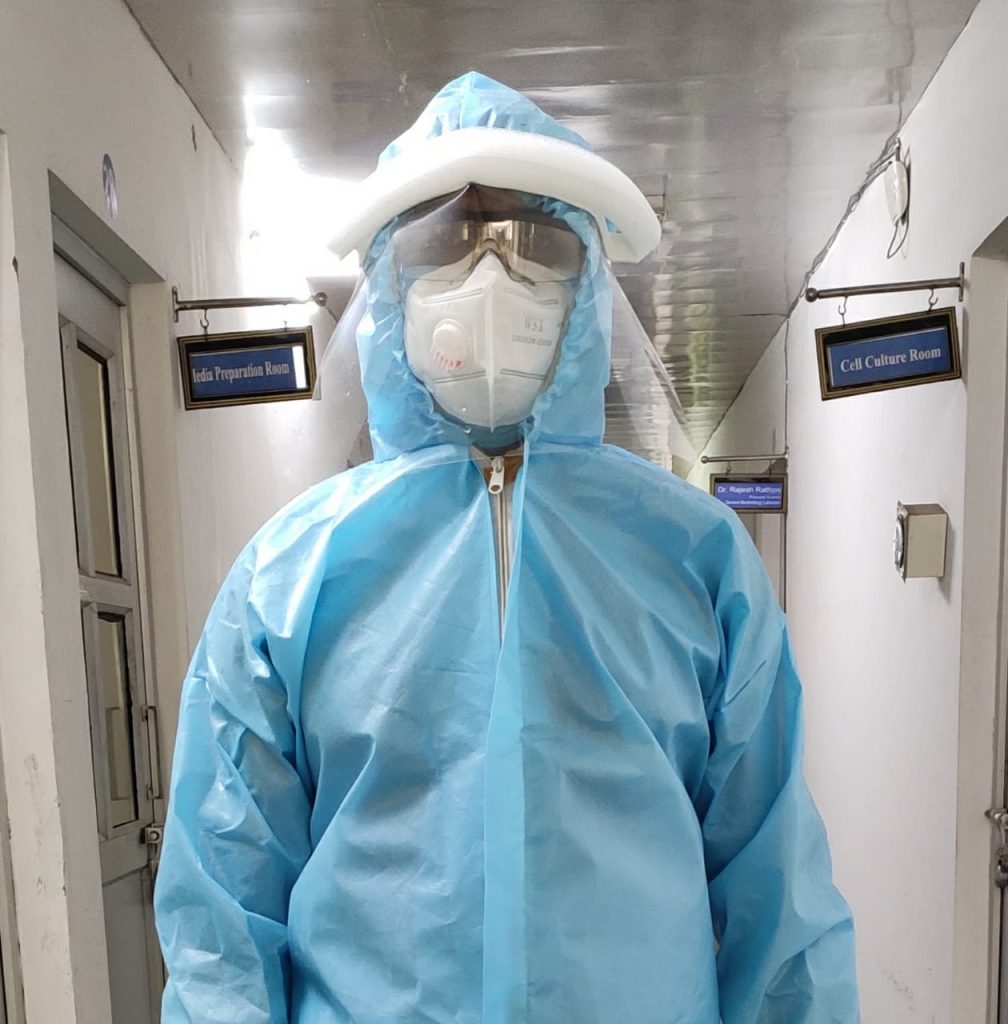
Fast forward to 2020, and the COVID-19 pandemic. Because of Mani’s studies and achievements, he was one of 20 scientists (out of 230) from the Division of Pathology, ICAR-IVRI chosen to survey, research, and diagnose the spread of the virus on the frontlines, processing over 160,000 COVID-19 tests from the state of Uttar Pradesh, India for months at a time. During this time, Mani was required to stay at a guest house to mitigate risk of spreading the virus. Although it was difficult, Mani takes pride in the country’s swift response and steady commitment to stopping the spread of COVID-19, and shares his gratitude for the experience.
Photo S. Mani: Saminathan Mani in personal protective equipment (PPE).
Although Mani has worked for ICAR-IVRI since 2015, his roles have evolved, with his most recent role being Senior Scale Scientist. Specifically, since 2021, Mani has worked with the Centre for Animal Disease Research and Diagnosis (CADRAD) in India. There, he researches emerging infectious diseases (lumpy skin disease, African swine fever, rabies), teaches and mentors bachelor’s, master’s, and PhD students, and conducts necropsy examinations on animals for disease diagnosis.
Despite placing great value on these rich experiences, Mani felt he could do more. So, when Mani discovered the ICMR-DHR Fellowship, he was compelled to apply.
In the submission process, applicants must reach out to global research universities of their choice to express their desire to continue their training. When looking at the list of suggestions from ICMR, Mani decided to email professors and researchers from a few universities that sparked his interest, one professor being GHI Director Jorge Osorio, professor of Pathobiological Sciences in the School of Veterinary Medicine at UW–Madison.
“Really, I liked the Global Health Institute’s approach for implementing the One Health concept. Because GHI has strong collaborations between human health care providers, animal health care providers, entomologists, engineers, sociologists, climate scientists, public health practitioners, and more. I strongly believe, this is possible because of GHI’s dynamic director. Jorge can truly achieve anything to which he sets his mind and is my role model,” said Mani.
Photo S. Mani: Osorio-left, and Mani at IGI airport, Delhi, India
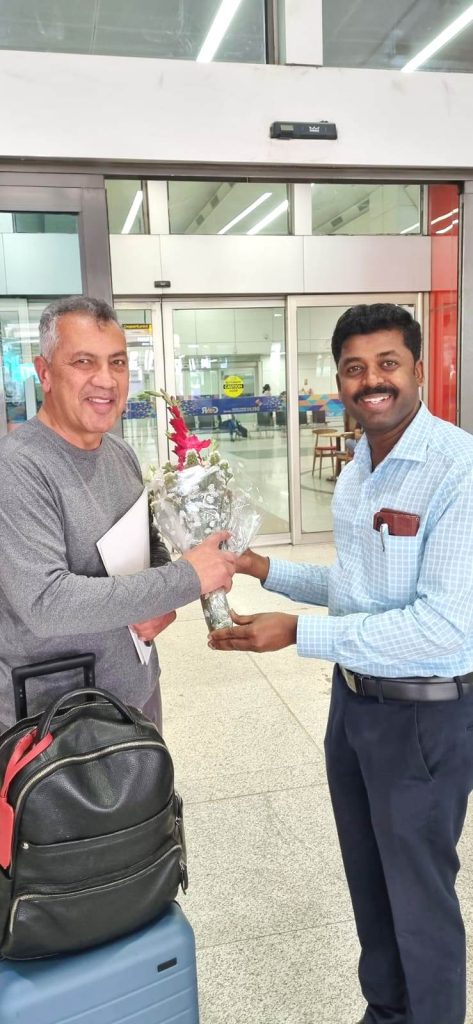
For a while now, Mani’s main research focus has been on rabies, a purely neurotropic virus, which affects the brain and nervous system. He currently works at a lab that confirms rabies cases, which can only be done by examining the saliva and brain. By gathering information from these confirmed cases, Mani and fellow researchers are working to develop rabies vaccinations, specifically models involving oral bait as incentive for animals to receive.
Mani shares the striking statistic that for every 36 people in India, there is one dog. He says the stray dog population is approximately 25 million, and reported dog bites are upwards of 17.5 million. Therefore, stray dogs are often linked to rabies cases across the country.
Growing up, Mani recalls crossing paths with stray dogs almost every day when walking to school. Usually, the stray dogs would only ever come close enough to give Mani and his friends a good scare. But one day, Mani wasn’t so lucky.
When he was 15 years old, and unfortunately, walking alone, Mani was chased by a group of stray dogs. After initially keeping the dogs at bay, Mani eventually found himself winded, surrounded, and left with a scar on his arm he will never forget.
“Since that day, I have felt haunted and tempted to work on a rabies vaccine,” Mani shares.
Despite the trauma from that incident, Mani tells his story with an optimistic tone – one which fuels him to keep researching and experimenting in hopes of mitigating the risk of rabies worldwide. What once frightened him now inspires him to do his best.
The journey to Madison was exciting for Mani, although it was bittersweet as his wife and children remain home in India. However, Mani plans to bring his wife, Deepa T, and his two children, one-year-old Dishanasree SD and four-year-old Subhiksha SD, to Madison this April, and have them stay until he completes his fellowship in June, 2025. Although the anticipation looms over him, his passion for research keeps him going.
When discussing his journey to Madison, Mani expressed his heartfelt gratitude to family, friends, and colleagues, including his father Mani Chinnavareddi, and mother Deivanai Mani, “Despite being humble agricultural farmers, they brought me to this stage through their hard-earned means.”
Upon further reflection, Mani acknowledged the mentors who instilled in him a love of learning and research, including Dr. Ramesh Somvanshi, Former Head, Division of Pathology, ICAR-IVRI; Dr. Karam Pal Singh, Former Joint Director, CADRAD; and Dr. Ram Bahal Rai, Former Principal Scientist, ICAR-IVRI. “Their guidance has been instrumental in shaping my journey.” Additionally, Mani is thankful to Dr. Triveni Dutt, Director, ICAR-IVRI, for recognizing his sincerity and encouraging his progress, and went on to thank friends, “I am deeply thankful to Dr. Arun Prince Milton, Dr. Pavulraj Selvaraj, Dr. Suresh Chinnathambi, and Dr. Gopalakrishnan Arumugam, who supported me during challenging times.”
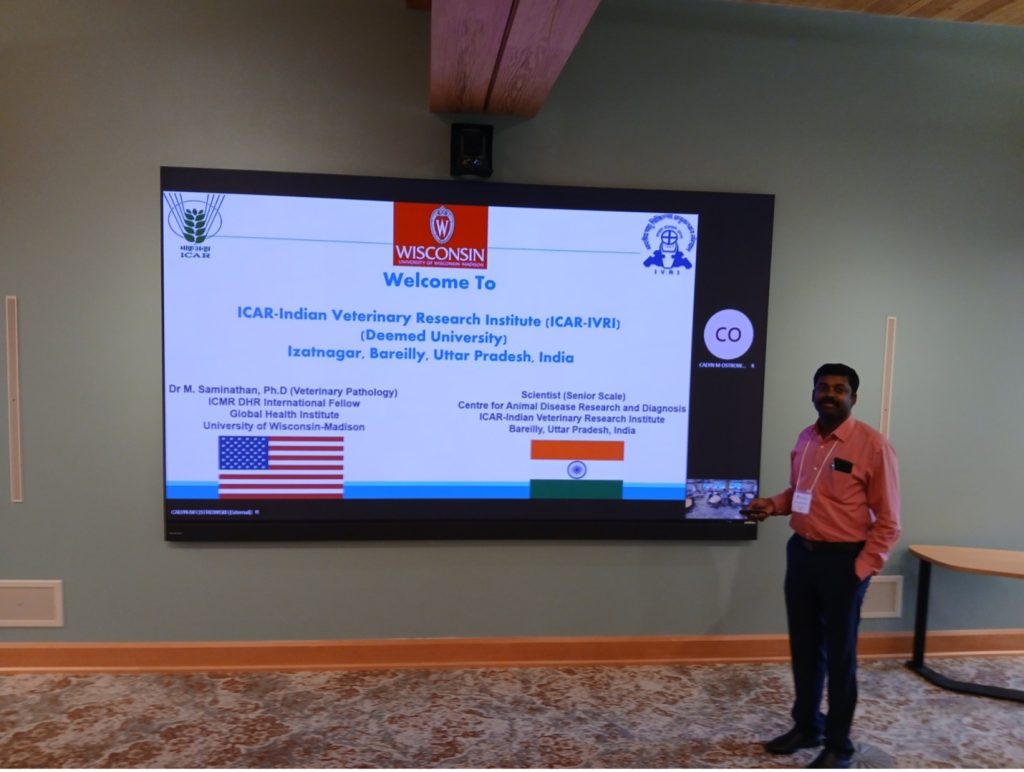
We know Mani’s story doesn’t end here. GHI looks forward to sharing his contributions to this collaborative work, following his progress, and finding opportunities to participate in joint research projects in the future.
As for Mani, he looks forward to the rest of his time at UW–Madison.
“I am proud to be a part of GHI and UW–Madison. I am proud to be a Badger.”
Photo S. Mani: Mani presenting his work at GHI’s Advisory Committee Meeting/Retreat at Usona Institute in late July
If you’re interested in learning more about Dr. Saminathan Mani, or would like to connect, reach out to him at msaminathan@wisc.edu; drswamyvet@gmail.com.
